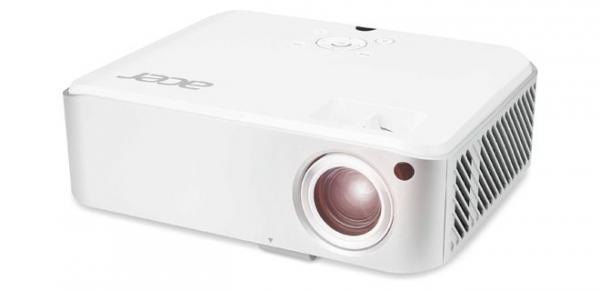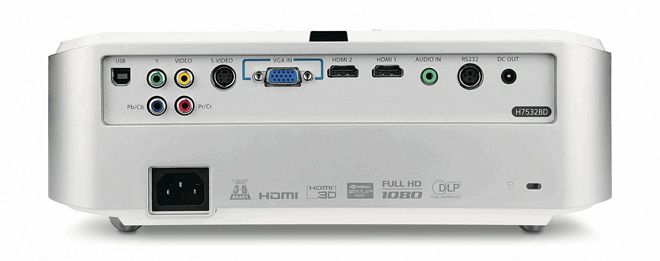Acer H7532BD 3D projector review

Most of Acer's projectors have been aimed at commercial and educational users, but a handful have been designed with home cinema in mind. Of these, the latest is the H7532BD. Surprisingly compact, this Full HD 1080p PJ sports all of the connectivity you'll find on bulkier units. First and foremost are the two HDMI inputs, which will accept 3D signals from suitable Blu-ray players, although no pairs of the necessary Active shutter glasses are supplied.
The H7532BD adheres to the DLP-Link standard for communication between PJ and glasses. Here, the shuttering signals are cleverly (and invisibly) projected onto the screen alongside the picture. No need to worry, then, about sporadic dropouts, or infra-red 'floods' overpowering your remote handsets. Relying on an agreed standard means a wider choice of glasses, too; Acer's are £70 a pop.
Among the rest of the connections are VGA (for computers), composite, component, a 12-volt trigger for motorised screens and even an S-video port for your long-forgotten S-VHS VCR. Whether you would want to feed noisy analogue videotape into a machine that's capable of throwing a 300in diagonal image is another matter.
You also get a silly little 3W audio system that foxed me when I first installed the PJ; I thought there was something wrong with my rear speakers. Mercifully, this 'squeaker' can be turned off.
Whatever your choice of source, it's directed towards a single 0.65in DLP DarkChip 3 – the same Full HD 16:9 imaging device that beats at the heart of the company's flagship H9501BD. Also common to both machines is a single-chip design, and so a colour wheel (a 6-segment type here) is required.
That DLP chip is driven by an Acer-specific video processing engine with proprietary tricks like 'ColorBoost II+'. The required light comes from an Osram bulb claimed to live for up to 4,000 hours in 'eco' mode, and is cast onto your screen via a 1:1.2 zoom lens.
The relevant controls for focusing and zoom are accessible from the PJ's top panel, which also harbours a pad of buttons. An absence of lens shift controls means you need to be careful where you site the projector relative to the screen. You should try to avoid using the digital keystone correction feature.
A decent onscreen test pattern is provided for lens adjustment and screen registration. Menu options accommodate front/rear and ceiling/desktop projection. If you choose to place the H7532BD on a flat surface (its diminutive stature, onboard sound and supplied carry-case make this a perfectly portable PJ), adjustable feet will help you align the picture.

An impressive array of adjustments are offered across the menus, including gamma, red/green balance (tint), dynamic black, noise reduction and a feature that compensates for coloured paintwork if you're projecting onto a wall. There are no colour temperature presets, but full control of RGB bias and gain are provided. These settings cannot be applied to the six preset viewing modes (among which are Movie, Game and Sport). Dare to make a change, and you're automatically taken into the seventh User mode. In other words, there's only one User memory – each input does, however, get its own, and there's also a bank dedicated to 3D, the various modes of which are engaged with a button on the tiny handset. In addition to Blu-ray 3D (frame packing), the H7532BD supports side-by-side and top/bottom modes. There's also a basic (and, very occasionally, convincing) 2D-to-3D conversion feature.
For all this, setup is straightforward – although when you're making adjustments, the picture can judder somewhat. Another complaint is that the image can take a while to settle after switching inputs.
Once fired up, black levels don't prove particularly strong, but can be improved (certainly for smaller pictures) by turning on the 'eco' mode. More concerning is the presence of DLP's rainbow effect, which I found quite distracting.
In 3D mode, rainbow is less apparent – and thanks to the light-attenuating qualities of the glasses, black levels fare better. Indeed, the H7532BD puts in a surprisingly good performance with 3D BDs. The first banshee flight of Jake Sully's Na'vi body (Chapter 17) in Avatar is reproduced in all its negative-parallax glory, and proves highly immersive.
Another telling 3D test is Prometheus' star-chart sequence, which ends with a projected Earth – the Engineers' intended target – fizzling into nothing. With the Acer, those whirling orbital patterns and intricate details are well defined.
Rainbow effect apart, the PJ's 2D performance is also more than acceptable. Bold colours pack punch, as a spin of Skyfall demonstrates, but delicate fleshtones aren't the most accurate I've seen.
As you might expect, Skyfall is rich in detail, and this is conveyed faithfully by the H7532BD. In its darker scenes, though, background subtleties tend to disappear; an upwards gamma tweak pays dividends. There's no untoward judder when 007 chases the mercenary Patrice across the rooftops of Istanbul (on a motorbike...) – just a smooth, clear, image.
So, visually, the H7523BD is on the whole satisfying, provided you're not too sensitive to DLP's notorious rainbow effect. It has other niggles, too (computer giant Acer should know that memory, for multiple user settings, is cheap) but its portability and fair price tag could win the H7532BD some friends.
HCC VERDICT
Acer H7532BD
Price: £870 Approx
www.acer.co.uk
Highs: Plenty of menu tweaks and inputs; small size and portability; excellent 3D image; bright; quiet in 'eco' mode
Lows: Rainbow effect can be distracting; fleshtones and black levels could be better; long input-settling times; no lens shift
Performance: 4/5
Design: 4/5
Features: 4/5
Overall: 4/5
 |
Home Cinema Choice #351 is on sale now, featuring: Samsung S95D flagship OLED TV; Ascendo loudspeakers; Pioneer VSA-LX805 AV receiver; UST projector roundup; 2024’s summer movies; Conan 4K; and more
|























































